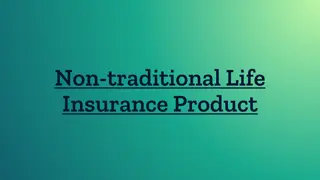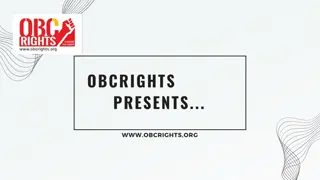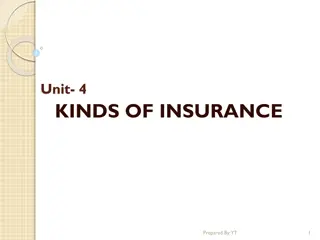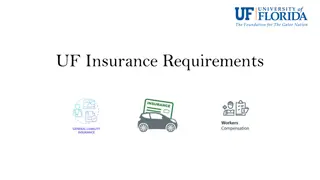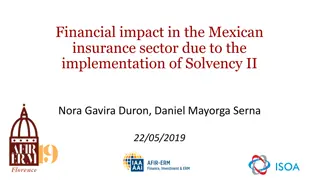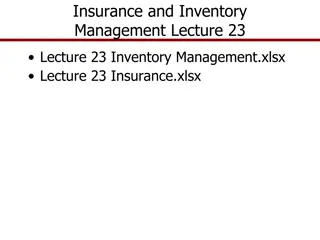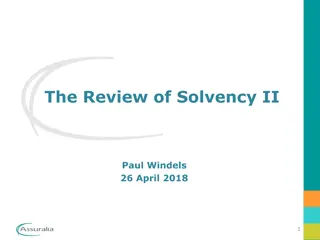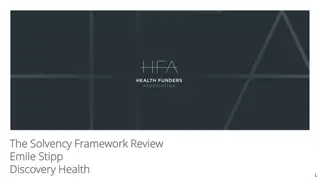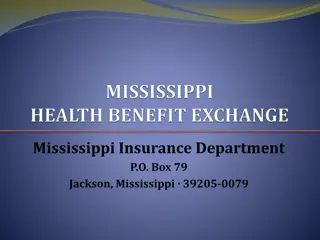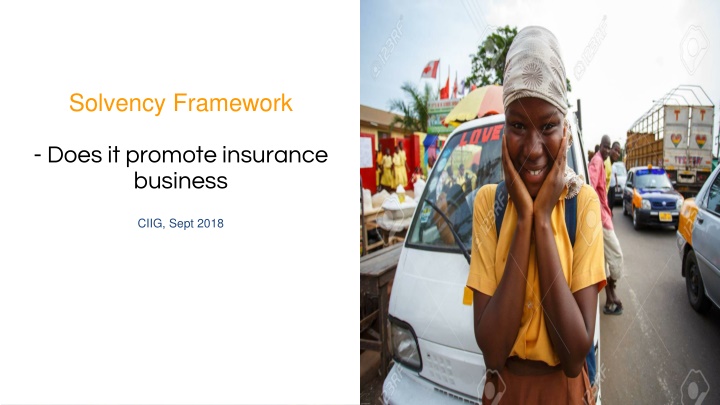
Solvency Framework for Insurance Business
Explore the components of the Solvency Framework, including capital resources, capital adequacy ratio, corporate governance, and contentious areas like assets discount and prudent margins. Learn how the framework promotes insurance business and calculates solvency capital requirement. Delve into the regulatory challenges and areas of contention within the framework.
Download Presentation

Please find below an Image/Link to download the presentation.
The content on the website is provided AS IS for your information and personal use only. It may not be sold, licensed, or shared on other websites without obtaining consent from the author. If you encounter any issues during the download, it is possible that the publisher has removed the file from their server.
You are allowed to download the files provided on this website for personal or commercial use, subject to the condition that they are used lawfully. All files are the property of their respective owners.
The content on the website is provided AS IS for your information and personal use only. It may not be sold, licensed, or shared on other websites without obtaining consent from the author.
E N D
Presentation Transcript
Solvency Framework - Does it promote insurance business CIIG, Sept 2018
The presentation covers: Contents 1. What is the Solvency Framework? 2. Contentious areas that could be seen as impediments? 3. Does it promote insurance business? 2
Building Block of Solvency Framework Capital Resources Capital Adequacy Ratio Corporate Governance Tiering of capital resources: Core and non-core capital Ratio of Available Capital Resource to Solvency Capital Resource 1. Investments related 2. Board related issues Disallowed assets 3. Risk Management SCR is the maximum of three items - Expense related - Volume related - Minimum of GHS3m Available capital resource is Capital Resource - Asset Discount - Prudent margins 4. Contingency Reserves
Calculation of CAR Item Current year Previous Year 1: Assets (Gross of reinsurance) 2a: Technical provisions (gross of reinsurance) 2b: Current & Other liabilities 2: Liabilities (gross of reinsurance) 3: Excess Assets: (1) (2) 4a: Disallowed Assets 4b: Non-core capital 4c: Prudent margins 4d: Asset Discounts 4: Available capital Resource: (3)-(4a)+(4b)-(4c)-(4d) 5a: Volume adjustment 5b: Expense requirement 5: Solvency Capital Requirement: Max(3,000,000 , 5a, 5b) 6: Capital Adequacy Ratio: (4)/(5) SDR1 seeks to compute the CAR CAR determines if a firm is solvent or not Capital resources is the sum of core and non-core capital Core capital is better quality assets compared to non-core Tip Assets are initial capital + retained earnings + contingency reserves + current year earnings Core capital is made to always be greater than non-core capital Non-core is made up of preference shares, unsecured subordinated debts, revaluation reserves etc Disallowed assets are intangibles, DAC, DTA, R&D, investments or amount owed by subs and connected persons, encumbered assets
The contentious areas in Solvency Framework are - Assets discount - Disallowed assets - Prudent margins - Minimum capital Requirements Other areas of contentions not in Solvency Framework - Requirement for control functions - Requirement for at least 7 board members - Independence requirements on boards - annual licence renewals Tip Questions to be answered are: Regulatory burden too high Cost of meeting regulatory requirements Amount of regulatory levies too high
Is Ghanas insurance industry overly regulated? - Compared with other insurance jurisdictions? - Compared with other regulated sectors? - Is regulated being applied fairly and not capriciously?
Why regulate insurance Market Power Imperfect Information Advance nature of insurance contracts Why What What is regulated Licencing requirements Solvency Premium rates Market conduct
Promotes best practice data, risk management, corporate governance Helps reduce shareholder interference Public confidence and trust Benefits of insurance regulation Promoting ethical market conducts Help ensure firms are solvent and meet policyholder liabilities when they are due - Deceptive sales practices - Rates not too high
My argument is that the benefits of the regulation of insurance in the long run helps to promotes insurance there are, however, regulatory costs and the question is that is the current costs too high?
Conclusion It boils down to philosophical questions Should the insurance industry be regulated If yes, is it being done such that the benefits outweighs the costs
Questions Thank you for your attention! 11


